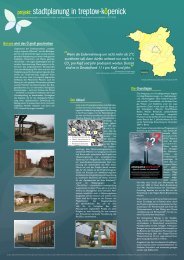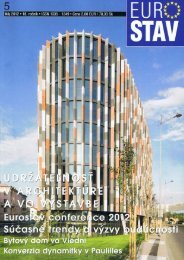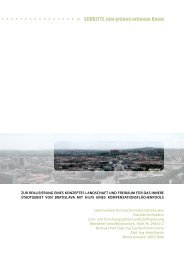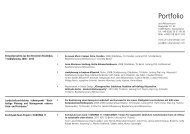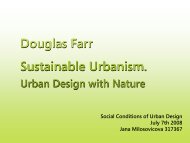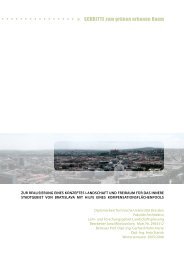Thesis document - Jana Milosovicova - Urban Design English
Thesis document - Jana Milosovicova - Urban Design English
Thesis document - Jana Milosovicova - Urban Design English
- No tags were found...
You also want an ePaper? Increase the reach of your titles
YUMPU automatically turns print PDFs into web optimized ePapers that Google loves.
a. b.On the other hand, a concave windward wall concentrates the flowalong this wall, upward and downward, increasing the turbulence.Setback of thetower of a high-risebuilding orhorizontal façadeprojections reducedownflow of thewind and minimizesnon-desiredturbulences on thestreet level causedby the high-risebuilding6-10 mSetbackof thetowerHorizontal façade projections3. Specific design details of the building itself. A setback of thetower, with respect to its base, starting about 6-10 m above streetlevel, can eliminate most of the downflow at the street, where theturbulence affects the pedestrians (fig. 38a). Such a design solutionstill maintains the positive effect on the mixing of the streetlevelpolluted air with the clearer air from above (Givoni 1998, p.297-298). Similar effect have horizontal projections on the façade,such as shading overhangs (fig. 38b) (Arens 1982, Givoni 1998, p.297).Fig. 38 Setback of the tower of a high-risebuilding or horizontal façade projections reducedownflow of the wind and minimizes nondesiredturbulences on the street level causedby the high-rise buildingAnother point to note is that one comparative study of ventilation instreet canyons with flat and with pitched roofs pointed out that theshape of roofs also has an influence on ventilation conditions in thestreets. The study showed that “pitched roofs cause recirculation of airnear roof level, hence reducing wind speeds at street level and causingpoorer ventilation (Barlow 2006).” Thus, for desired intensity ofventilation, flat roofs are to be favoured. 27Summarizing the above considerations and knowledge on ventilationin urban areas, the difficulty in suggesting an urban form that wouldmake the most efficient use of wind flows in moderate climate cities –providing sufficient ventilation on one hand and human physical comfortthroughout the year on the other hand 28 – becomes evident.Yet, it seems likely that a mid- to high density urban form, withstreets possibly angled in parallel direction of the wind (or ina small angle to the direction of prevailing winds), and, whereneeded, with a few thoughtfully placed high-rise buildings thatcause stirring up of the wind masses on the street level, wouldprovide sufficient ventilation while preventing street canyonsfrom overradiation. Additional ventilation channels reachingfrom the urban outskirts into the urban core as well as localventilation channels between inner-city green areas and waterbodies will provide ventilation and cold air transfer on the levelof the whole city.It is also important to note, that whether the ventilation designing strategiesaim for significant wind streaming or against it, light winds are alwaysdesirable in the streets and open spaces, to mitigate the effect of solarheating (Givoni 1998, p. 289) and of the anthropogenic heat release.27 Flat roofs also have an advantage of easy installation of green roofs in combinationwith photovoltaic panels. Roof vegetation cools the air in the proximity of thephotovoltaic system and thus enhances its efficiency and energy yields (Köhler etal. 2002, p. 157).28 The desirability of higher or lower wind speeds in moderate climate zone dependon the given season. In general, in summer months, ventilation and sunprotection are desired – in winter, unobstructed insolation and protection fromwinds. These requirements are difficult to fulfill, because, for example, if vegetationsuch as robust deciduous trees is used, desired shading in summer will beachieved – but also ventilation obstruction due to the thick treetops. On the otherhand, bare tree skelets allowing sunlight in the winter don‘t protect against thewind. These controversial aspects are to be considered and weighted in everyspecific planning situation.30Climate Sensitive <strong>Urban</strong> <strong>Design</strong> in Moderate Climate Zone: Responding to Future Heat Waves. Case Study Berlin Heidestrasse/Europacity



